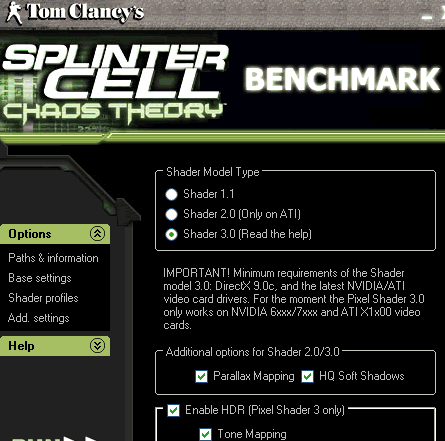Asus EAX1950XTX
8. Splinter Cell Chaos Theory
Review Pages
 A Japanese Information Defense Force is formed to help face modern threats. Deemed a violation of international law and of the Japanese Post-War Constitution, Korea and China become outraged.
A Japanese Information Defense Force is formed to help face modern threats. Deemed a violation of international law and of the Japanese Post-War Constitution, Korea and China become outraged.
Secretly, the head of the IDF begins launching information-warfare attacks against Japan and blaming the attacks on North Korea. When the U.S. intervenes, as they are obligated to under Article 9 of the Japanese Post-War Constitution, the U.S. is attacked as well, forcing North Korea to escalate the situation with a pre-emptive invasion of South Korea. As war erupts on the Korean Peninsula, Sam Fisher must thwart the alliance between the Japanese Admiral, a neurotic computer hacker, and the head of an international paramilitary company in order to prevent the rekindling of a massive world war in the Pacific.

The graphics engine supports Pixel Shader 1 and 3, HDR along with other new effects. We used hocbench which offers all benchmarking options from an easy to use GUI. We used the built-in "Guru3D 2" timedemo and all results are posted below, using SM1.1

The Asus EAX1950XTX is still the fastest performing single card with 83FPS. That's 12FPS more than the eVGA 7950GT KO! The 7950GT SLI card still holds first place with 113 FPS. Splinter Cell - Chaos Theory also supports Shader Model 3.0 that can be enabled easily with the hocbench software:


SM3.0 offers much better visual details but with a performance hit. Interestingly, the Asus EAX1950XTX seems less affected and outperforms the 7900GS SLI setup.
Splinter Cell Chaos Theory doesn't offer AA/AF modes, so we had to enable them from each card's 3D Control panel.

Enabling AA/AF drops the performance of all cards, to some degree. Both ATI based cards showed good stability with AA/AF enabled, maintaining a constant framerate regardless of AA/AF combination.
Review Pages





















